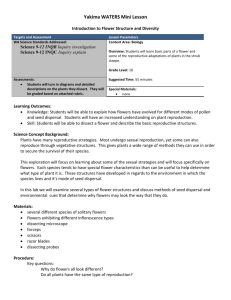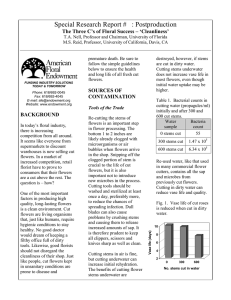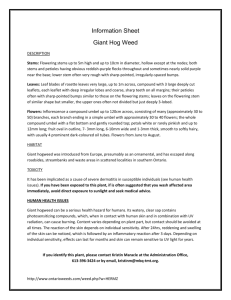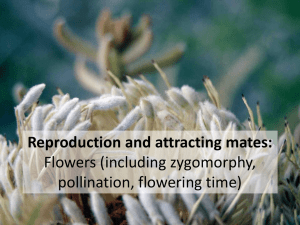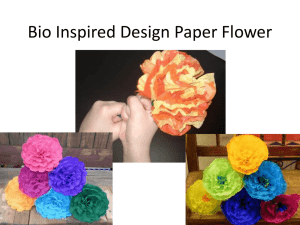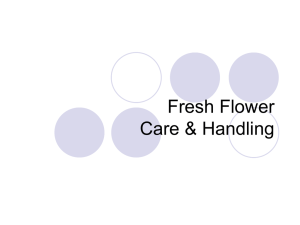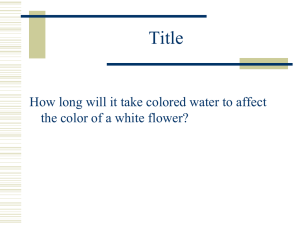Cut Flower Conditioning
advertisement
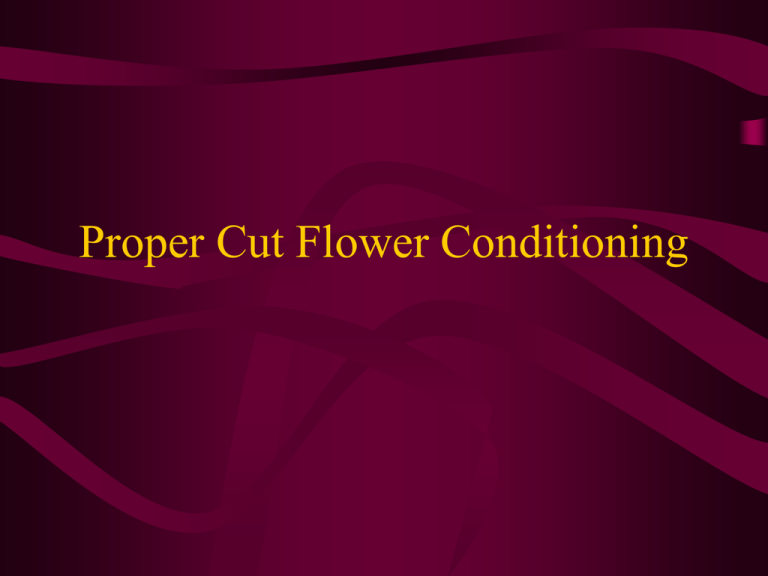
Proper Cut Flower Conditioning Clean Buckets • Clean all your buckets with bleach (or effective green cleaner) & a scrub brush – to kill bacteria, fungus, etc • Rinse well • Use plastic or glass containers – not metal – it will corrode & contaminate the water Cut Flower Food • Mix the appropriate amount of cut flower food – Improper mixtures can result in not providing enough biocides in relation to sugars • Using soda, aspirin or any other homemade mix isn’t as effective as cut flower food because it isn’t measured out correctly like cut flower food • Cut Flower food contains: – – – – – Sugars (help provide energy in usable form) Aging retarders(growth regulators)/color enhancers Chemicals to quicken absorption of water (wetting agent) Bacteria killers (biocides = germicide) Acidifiers to lower pH (this helps with better absorption & less bacterial growth) Water • Warm –110 Degrees- like bath water – for most flowers – Warm water helps remove air bubbles, making for easy water flow up the stem (warm water contains less oxygen than cold) – Warm water will also encourage flowers to open quicker – Warm water absorbs faster because warm water molecules move faster • Cool – for bulbs (daffodils, tulips) and any other flowers that you don’t want to open too quickly • Buckets should be filled 6-8” with water Cutting • When flowers have been out of water the exposed outer cells dry out, forming a callus, which will not absorb the water – Additionally, air will have entered the stem, bacteria, and other pollutants – preventing water absorption • Cut about 1-3 inches off the stem • Use a knife or very sharp pruners – if your tool is dull, it will crush the plant cells and they won’t absorb • Cutting under water will help prevent air bubbles, but can also pollute the stems when the water becomes unclean • Cut at an angle to keep the stem from sitting directly on the bottom of the bucket, where debris, etc. will clog the stem (not proven) • Cut between the internodes on flowers like carnations Removing packaging & foliage • All elastics & plastic should be removed, except for roses and greens. • If you keep roses wrapped up they won’t blow open as fast. However, you cannot keep them wrapped for more than a few days – they will rot. • It is more effective to keep certain greens in plastic rather than in buckets of water • All foliage that would be in the water should be removed – it will rot & clog the stems – Be sure to avoid scraping the stems when removing leaves Absorbing • Leave flowers out of the cooler for 3-5 hours so they can absorb correctly • Put roses in immediately • Put bulb flowers in immediately • Do not put tropical flowers (bird of paradise) in the cooler – they should be at warmer temperatures (so unless you have a special warmer cooler for them, keep them out) Orchids can go in the cooler. • If your flowers are really dehydrated, you can submerge the entire flower after it is cut into a tub of water Floral Coolers • Do not keep food, especially fruits, in your floral cooler – these items give off high amounts of ethylene gas which speeds up aging. Dying flowers will do the same so remove them. • Coolers should be kept at 38- 40 degrees F, tropical coolers at 55-60 F • Relative humidity of 80% • Must have a FLORAL cooler – non-floral coolers have one large fan blowing fast air – this dries out petals Change water in buckets • You should recut stems and change the water in buckets if possible every 3 days • This will extend the vase life of the flower • Vase water has bacteria, fungi, yeasts, & mold which block xylem and produce ethylene and toxins Special Notes on Flowers • Lillies – remove anthers to prevent staining & pollination which will cause the flower to die quicker • Baby’s Breath – use warmer water to “pop” buds • Bird-of-Paradise – manually open flower heads • Calla – only 1” of water to minimize curling of stems • Roses – remove outer damaged petals (this will encourage opening as well); only remove thorns that need it – this damages tissue & will cause early death • Daffodil – sap is harmful to other flowers when conditioned; keep separate & do not recut stems when designing • Gerbera – use a rack in the bucket for support • Hydrangea – dip in alum (spice/pickling) • Snapdragons & Tulips – store in upright to prevent geotropism • Gladiolus – remove top bud to encourage others to open • Poinsettias and other flowers that secret latex – burn the end – this opens water conducting while sealing
